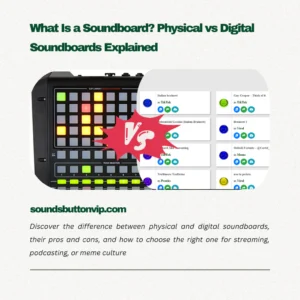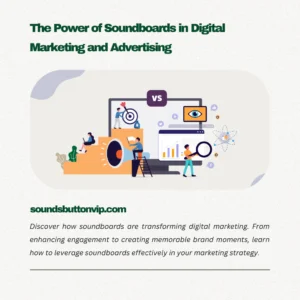The Power of Soundboards in Digital Marketing and Advertising: Boosting Engagement and Brand Identity
As digital marketing evolves, brands constantly seek innovative ways to captivate their audience. Among the newest trends in interactive marketing, soundboards are emerging as a powerful tool to enhance user engagement, strengthen brand identity, and create memorable experiences. But what exactly is a soundboard, and how can it be leveraged effectively in marketing campaigns? Let’s explore its potential and the best practices for incorporating it into your strategy.
What is a Soundboard and How Does it Work in Marketing?

An interactive soundboard integrated into a website or app allows users to engage
A soundboard is a tool that allows users to play predefined sounds with the press of a button. In marketing, soundboards are often used to trigger sounds that either entertain, inform, or emotionally engage users, making the interaction more memorable. From quirky sound effects to motivational jingles, soundboards offer a unique form of interaction that can elevate the user experience and create a lasting impact.
In the context of digital marketing, soundboards are typically integrated into websites, mobile apps, social media campaigns, and even live events. Their purpose? To create a sensory experience that complements visual elements and draws users in.
The Power of Sound in Digital Marketing
Sound has a profound impact on human behavior, affecting how we perceive messages, recall information, and feel emotionally connected to a brand. By integrating sound into marketing strategies, brands can:
- Increase Engagement: A well-timed sound can draw attention and encourage users to interact with a brand’s content, making them more likely to engage with calls to action (CTAs).
- Enhance Brand Identity: Unique sounds, like jingles or reaction clips, can become associated with your brand, helping consumers instantly recognize your business.
- Trigger Emotional Responses: Sounds evoke emotions, whether it’s excitement, nostalgia, joy, or even urgency. This emotional connection can influence purchasing decisions or brand loyalty.
- Amplify User Experience: Audio cues provide instant feedback and create an interactive experience that adds a layer of fun, making digital interactions feel more dynamic and rewarding.
Practical Applications of Soundboards in Digital Marketing
Now that we’ve explored the benefits of sound in marketing, let’s take a closer look at how soundboards are practically used in digital marketing campaigns.
Interactive Web and App Campaigns
One of the most common uses of soundboards is to make websites or apps more interactive. For example, e-commerce websites can use sound effects to signal when a user adds an item to their cart or completes a purchase. These sounds provide immediate feedback and encourage users to continue their journey, creating a fun and engaging shopping experience.
Enhancing Social Media Engagement
In social media campaigns, soundboards can add an element of surprise and humor. Brands can create sound effects for memes, viral moments, or user interactions. For instance, triggering a “cheer” sound when a follower subscribes or leaves a comment makes the experience more engaging. These playful interactions can increase shareability and boost user participation.
Gamified Advertising and Promotions
Soundboards are also ideal for gamified advertising experiences. Brands can create games or challenges where users can trigger sound effects by completing specific actions. These sounds can act as rewards or feedback, motivating users to interact with the campaign and share it with others.
Event and Live Stream Experiences
In live events or streams, soundboards can amplify the excitement and fun of the broadcast. Whether it’s adding sound effects when milestones are reached (like a subscriber goal) or using humorous audio clips to comment on live events, soundboards keep the energy high and the audience engaged.

Soundboards in live streams and ads create dynamic interactions
Brand Sound Branding
Soundboards also play a role in sound branding. A unique jingle, catchphrase, or sound effect tied to a brand can significantly enhance recognition. Think of how jingles like “I’m lovin’ it” from McDonald’s or the “Intel Inside” melody immediately recall the respective brands. Soundboards can be used to trigger these branded sounds in various touchpoints of a user’s interaction with the brand.
Best Practices for Using Soundboards in Marketing
While soundboards offer exciting possibilities, they need to be used strategically. Here are some best practices to ensure they’re effective in your marketing campaigns:
- Keep It Brief: Choose short, punchy sounds that complement your message. Avoid long, distracting sounds that could annoy users.
- Ensure Relevance: Choose sounds that fit the context and the message you want to convey. Sounds should align with the tone of your brand and your campaign goals.
- Offer Control: Always give users the option to turn off or control the volume of the sound effects. Autoplaying sounds can be jarring for users, so providing them with control is important for a positive experience.
- Test and Iterate: Test the effectiveness of your sound effects with a small audience before going live. Gather feedback and make adjustments as needed to ensure the sounds add value without overwhelming the user.
Examples of Brands Using Soundboards Successfully
Several brands have embraced soundboards in their marketing campaigns, and here are a few that have done it well:
- Spotify: The “Spotify Wrapped” campaign incorporated personalized audio snippets, allowing users to share their favorite tracks along with sound effects that made the experience feel more engaging.
- Heineken: Heineken has used sound effects in their experiential marketing campaigns, triggering cheers and applause when users interact with their displays, creating a fun and memorable experience.
- Coca-Cola: Coca-Cola has used sound branding in ads and events to evoke feelings of happiness and nostalgia, such as the signature sound of a can being opened or poured into a glass.
Conclusion
Soundboards are a dynamic and interactive tool in digital marketing and advertising. When used strategically, they can boost engagement, enhance user experience, and build a memorable brand identity. By integrating sound thoughtfully, brands can enhance user experience and create a lasting connection with their audience. Just remember – balance is key. Use sound thoughtfully, test it for user feedback, and ensure it aligns with your campaign’s goals.
Looking for sound buttons to use in your next campaign? Visit soundsbuttonvip.com to explore a variety of free, customizable sound buttons that can elevate your marketing efforts and engage your audience in a fun, memorable way!

I’m Jabari, and I collect, curate, and share sound buttons for free – just because I love them. SoundsButtonVIP.com is my little gift to anyone who enjoys sound as much as I do.









